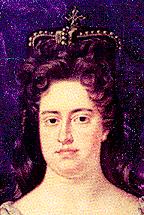Queen Anne
From the Quicksilver Metaweb.
This is an intermediate page for Queen Anne.
Stephensonia
The cheeky colonists in New England talked about Anne as if she were already dead and George I already was on the throne as Quicksilver opens the first book.
Authored entries
- Stephenson:Neal:Quicksilver:18:...heard by their future Queen... (Chris Swingley)
- Stephenson:Neal:Quicksilver:18:...heard by their future Queen... (Alan Sinder)
- Stephenson:Neal:Quicksilver:18:...behaving as if Queen Anne were already dead and buried,... (Alan Sinder)
- Stephenson:Neal:Quicksilver:176:Black Velvet (Scott Elkin)
- Treaties terminating wars - One of Daniel's Logic Mill Cards
Anne of Great Britain
Queen Anne (February 6, 1665 - August 1, 1714) the first Monarch of the Kingdom of Great Britain, and also separately Queen of Ireland (March 8, 1702 - August 1, 1714), was the second daughter of King James II of England from his first, Protestant, wife. At the time her parents were Duke and Duchess of York, the monarchy had only recently been restored, and there was still every prospect of King Charles II of England, Anne's uncle, producing a male heir.
Anne
Queen of England, Ireland and Scotland until 1707
Queen of Great Britain, Ireland from 1707
In 1683, Anne married Prince George of Denmark (another Protestant state), and the couple had 17 children, most of whom were still-born. None survived long enough to ascend to the throne, the longest-lived being William Henry, Duke of Gloucester, who died in 1700 at the age of eleven. When Anne's father, James II, took as his second wife the Catholic Mary of Modena, concern grew that they would produce a son and that James would attempt to restore Roman Catholicism as the prevalent faith within Britain. James was deposed in 1688, in favour of his elder daughter, Mary (who became Mary II of England), and her husband, William of Orange. However, they were childless, and the succession passed to Anne in 1702. Unfortunately, her surviving son, William, had died two years earlier, and she failed to produce another heir.
Anne's reign is best remembered for two things: a distinctive style of architecture; and the influence of the Churchills. John Churchill, an outstanding military commander, was created Duke of Marlborough following his victory at the Battle of Blenheim in 1704. He owed his favour with the queen partly to her long-standing friendship with his wife, Sarah. When, in about 1711, the two women fell out, the Duke and Duchess both lost preferment. It was also during Anne's reign, in 1707, that the Scottish Parliament ceased to exist as a separate entity (until it was reintroduced in 1999).
Queen Anne died in 1714 and is buried in Westminster Abbey. The succession passed to her nearest Protestant relatives, the rulers of Hanover in Germany. The first in line was the Electress Sophia, but she died a few weeks before Anne, and her heir succeeded to the throne as King George I of Great Britain.
The term, Queen Anne, when applied to a style of furniture or architecture, refers to this monarch.
From 1702 to 1712, Queen Annes War -- the second of the French and Indian Wars was fought mostly in New England.
